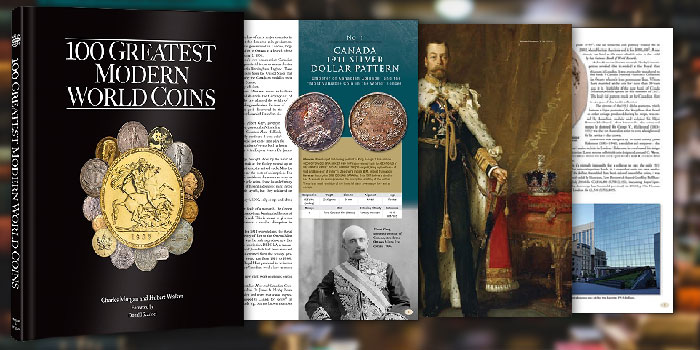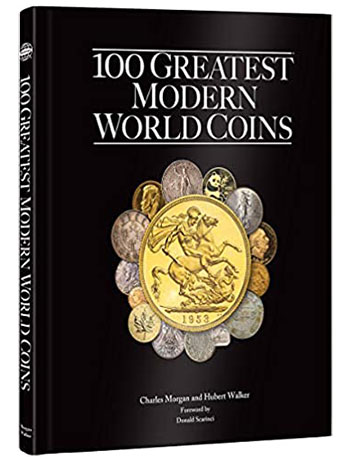
First Read, a continuing series of essays about classic and contemporary works of numismatic literature …
By Louis Golino for CoinWeek …..
If you are a collector of American coins, you probably have long considered those coins issued in copper-nickel since 1965 (as well as modern bullion and commemoratives) to be “modern” coins and earlier issues to be “classic” coins.
But as authors Charles Morgan and Hubert Walker, who serve as the editors of this website, argue in their new book, 100 Greatest Modern World Coins, a better way to define modern coins is to link them to the industrialization process that wealthier economies experienced in the first 80 years of the 20th century and to the modernization of Asia and Latin America during this period – two key forces that created the world of the 20th century.
The book’s focus on world coins issued since 1901 is based on a slightly different definition of modern world coins than the one provided by numismatist and Citizens Coinage Advisory Committee (CCAC) veteran Donald Scarinci in his foreword to the book, which is coins issued since the advent of the Janvier reduction method in coin production that began in the mid-to-late 1800s. Focusing on 20th-century coins, as the author’s note, was based on their view that the coins of this period are important in their own right and “deserved to be considered among their peers.”
In choosing their 100 greatest world coins of the 20th century, the authors build on the criteria set forth in the first Whitman book in the “100 Greatest” series, Jeff Garrett and Ron Guth’s 100 Greatest U.S. Coins, which were: rarity, value, quality, popularity, beauty and history.
But unlike the coins of the earlier volume that form a homogenous group, the much more diverse group of coins issued around the world since 1901 required a different set of criteria for the authors, which are: rarity; innovation (such as new metal alloys, new motifs, and coinage reforms); coin sets (a number of the greatest world coins include special coin sets or were part of sets); oddities and emergency issues, such as coins issued just before a leader was overthrown; and auction and market values.
Emphasis on Rarity
The authors acknowledge that the coins that made their list include a large number that are so rare and valuable that they are well beyond the means of most collectors – or are even impossible to own for various reasons. In fact, only 23% of the coins discussed here are valued under $10,000, but Charles and Hubert do include some issues that any collector can afford, such as #100, the 1999 euro coin set, and a couple of modern bullion issues, such as #57, the 1967 South African gold Krugerrand and #66, the 1979 Canadian Gold Maple Leaf, the first two modern world gold bullion coins.
The book covers the rarest and most numismatically significant issues from countries around the world that are, in many cases, not well known outside the country where they were issued. Others are well known to those who collect coins of specific countries, such as #7, the Proof version of the 1930 Melbourne Penny from Australia, which is considered the “King of Australian Coins”, or #1, the 1911 Canada Silver Dollar Pattern, of which only two exist and only one of them is in private hands.
(Fortunately, in cases where a coin is essentially impossible to own, they also discuss more accessible versions if they exist, such as electrotypes.)
When one compares the uber-rare world issues covered here with the rarest U.S. coins, it is evident that there are far more coins of this type among 20th-century world issues. Mintages and the examples that are not in museums are far fewer and scarcer than their American counterparts, and many of them seem considerably underpriced compared to rare American issues. For example, the 1921-B British Trade Dollar with five known surviving examples sold for $45,000 in a 2014 auction. Any American coin that rare would likely sell for at least 10 times that amount, if not more.

While this trend reflects the strength of the U.S. coin market, the modern world field is evolving, and rare world issues have seen their values increase sharply in recent years, especially rare Chinese issues whose market has been fueled by the rise of the Chinese middle class in recent decades.
The geographic coverage of the coins is well balanced with the coinage of Asian countries, especially rare Chinese issues, constituting about 15% of the list, while those of Great Britain and other commonwealth nations make up about 20%. Coinage from continental Europe amounts to 25% of the group, Russia 5%, and the remaining issues are predominantly from the Middle East and Latin America.
When I first learned of how many coins in the book are so rare that they are impossible or virtually impossible for a collector to obtain (25% of the list), my initial reaction was that perhaps the authors had overemphasized the rarity factor. But while reading the book, I came to better understand their reasoning for including these coins, which is to stimulate interest in this area of numismatics and enrich the knowledge of collectors of these landmark numismatic items, which can inform their pursuit of the coins they can afford.
This makes a lot of sense if one considers, say, the 1933 Double Eagle, which is not even legal to own, apart from its value of millions of dollars. Numismatists are not interested in it because they have plans to acquire an example, but rather they love to learn about the fascinating history behind the coin. The same is true of the amazing world coins covered here.
Moreover, the authors also acknowledge the fact that other collectors have their own lists of greatest coins. With a field this diverse, that is inevitable.
Strengths of 100 Greatest Modern World Coins
Charles and Hubert’s book is a major contribution to the study of modern world coins that deserves to be read by many collectors no matter what their specific interests are in numismatics. This volume provides more detailed narratives than those of most of the other books in the “100 Greatest” series that clearly reflect the interest and knowledge both authors have in world history and that goes far beyond the usual market analysis that tends to accompany the discussion of coins in articles and books. Their clear and precise writing reflects their backgrounds as experienced numismatic editors and journalists; in fact, Charles is, to my knowledge, the only editor of a major numismatic publication whose primary collecting interest is world coins.
In addition, the book is lavishly illustrated and provides a wealth of information about the mintages, surviving populations, motifs, designers and engravers, and auction and sale of the coins discussed in the book and of the historic context in which each coin was issued. Their strong emphasis on that history reflects what the true spirit of numismatics is and should be, which is the knowledge we gain about a wide range of fields, from art to history, economics, and much more as we pursue our hobby and build our collections. As I often tell those who are curious about what motivates people to collect coins, it is not about making money. That is what inspires people to be a dealer or a seller, not a collector.
Even if you are a specialist in modern world coinage and especially if you are an average collector with a keen interest in these coins, you will learn a great deal about coins and world history from this volume. And each coin’s narrative stands on its own, so the book does not need to be read from start to finish. Delve in wherever you want based on your interests and go back later to read about other coins.
100 Greatest Modern World Coins provides an essential and well-written overview of the most significant world coins of the 20th century and brings together a wealth of information from many sources, including consulting with experts on these remarkable coins. It should help to increase the number of American collectors of this fascinating area of numismatics and begin to bridge the gap that exists in existing numismatic reference works between those on modern world issues compared to the larger literature on American coins.
* * *
 Louis Golino is an award-winning numismatic journalist and writer, specializing primarily in modern U.S. and world coins. His work has appeared in CoinWeek since 2011. He also currently writes regular features for Coin World, The Numismatist, and CoinUpdate.com, and has been published in Numismatic News, COINage, and FUNTopics, among other coin publications. He has also been widely published on international political, military, and economic issues.
Louis Golino is an award-winning numismatic journalist and writer, specializing primarily in modern U.S. and world coins. His work has appeared in CoinWeek since 2011. He also currently writes regular features for Coin World, The Numismatist, and CoinUpdate.com, and has been published in Numismatic News, COINage, and FUNTopics, among other coin publications. He has also been widely published on international political, military, and economic issues.
In 2015, his CoinWeek.com column “The Coin Analyst” received an award from the Numismatic Literary Guild (NLG) for Best Website Column. In 2017, he received an NLG award for Best Article in a Non-Numismatic Publication with his piece, “Liberty Centennial Designs”.
In October 2018, he received a literary award from the Pennsylvania Association of Numismatists (PAN) for his 2017 article, “Lady Liberty: America’s Enduring Numismatic Motif” that appeared in The Clarion.




